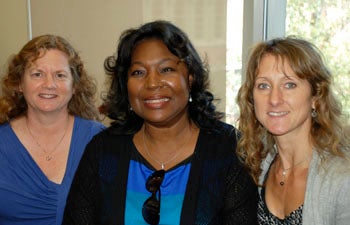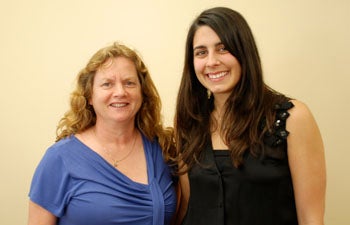Springboard to Teaching STEM
Like divers, 60 teachers, magnet coordinators and principals from the Los Angeles Unified School District (LAUSD) lifted their arms high over their heads and flexed their knees as if preparing to plunge from imaginary springboards.
The educators were participating in a professional development workshop led by Jill McNitt-Gray, professor of human and evolutionary biology in USC Dornsife, who was demonstrating how techniques employed by Olympic divers can be used as innovative and inspiring tools to teach students STEM (science, technology, engineering and math).
“STEM workshops provide valuable opportunities for teachers to share ways of engaging students in the learning process,” McNitt-Gray said. “When students become active participants in the learning process they can discover for themselves how science, engineering and math are relevant to them and their world.”
The mainly fourth and fifth grade teachers gathered on March 12 at the Ronald Tutor Campus Center to attend a STEM enrichment workshop led by USC Dornsife and USC Viterbi School of Engineering faculty and post-graduate researchers. Teachers and principals from five USC community schools — Norwood Street Elementary School, 32nd Street/USC Visual and Performing Arts Magnet, Vermont Avenue Elementary School, Lenicia B. Weemes Elementary School, and James A. Foshay Learning Center — participated in the workshop.
Run by USC Dornsife’s Joint Educational Project (JEP), the workshop was the second held this year as part of JEP’s Young Scientist Program (YSP).
“With everything they do for our kids, I believe teachers really are our unsung heroes,” said Tammara Anderson, JEP executive director. “It’s really important to give our teachers encouragement and information and let them know they have resources here at USC they can count on.”

Tammara Anderson, JEP executive director (center); Jill McNitt-Gray, professor of human and evolutionary biology in USC Dornsife (left); and Tina Koneazny, associate director of administration and educational outreach at JEP, during the March 12 STEM Educator Enrichment Workshop for LAUSD educators.
The aim of the YSP’s professional development workshops is to reinforce the California Academic Content Standards in Science and Mathematics while examining student-retention strategies, e-learning, STEM evaluation, pedagogy and assessment. The initiative also provides teachers with support, encouragement and access to multiple resources.
The workshop united STEM educators to discuss how together they can improve science education in the community.
Antonia Zaferiou, a Ph.D. student in biomedical engineering in McNitt-Gray’s laboratory, showed participants a video of a Technology, Entertainment and Design (TED) lecture that used dancers and choreography instead of PowerPoint to explain complex scientific concepts. Zaferiou suggested teachers employ similar techniques in the classroom by getting students to physically replicate the movement of blood as it is pumps through the human heart by acting it out. Some students in the routine could play chambers of the heart and others could represent blood flow.
“My middle school teacher taught us the quadratic equation by singing it to us and to this day that is how I remember it,” Zaferiou said, before acquiescing to popular demand and warbling the equation to the tune of Pop Goes the Weasel.
“There are so many ideas out there to create unique ways of teaching which don’t require much equipment or entail monetary constraints,” Zaferiou said. “We can squirt water guns or use a hose in the backyard to demonstrate ideas of projectile motion, or we can use water and ice to discuss how volume changes when water turns from liquid to a solid state. We are surrounded by science.
“So I would tell teachers, just be creative and use your interests and strengths to enhance classroom learning.”
The workshops also provided participants with the opportunity to partake in several fun and instructional activities which they can take back to the classroom to share with their students.
Led by Zaferiou, teachers cut paper plates into abstract shapes and used intersecting vertical lines to find the center of mass. The exercise was a good illustration of how teachers can use everyday objects to create fun, interactive projects to teach STEM subjects.

Jill McNitt-Gray (left), professor of human and evolutionary biology in USC Dornsife, and her Ph.D. student in biomedical engineering, Antonia Zaferiou, each attended the workshop and presented innovative and inspiring ideas to 60 local educators who teach STEM subjects.
The YSP is funded in part this year by The Boeing Company. Boeing’s grant enabled the creation of high-quality teaching support materials for workshop participants once they return to the classroom. These include the development of a six-part PDF curriculum guide, lesson plans, workshop notes, curriculum video and information on available resources.
Nadine Afari, YSP director and lecturer at USC Viterbi, conducted focus groups at each school in order to find out what the teachers wanted from a STEM professional development workshop series.
“As well as professional development programs and current science content, teachers asked for resources,” Afari said.
They wanted information on summer camps, family science programs and field trip ideas, as well as to discuss with USC faculty how to get their students excited about STEM fields so much they will want to study such subjects at a university.
YSP gave educators what they asked for by providing them with the opportunity to discover and connect with 12 local STEM organizations over the two workshops. Representatives from a wide variety of organizations, ranging from the California Science Center to the Goldstone Apple Valley Radio Telescope Project (GAVRT) at the NASA Deep Space Network to the Family Science Center at Iridescent Learning, attended the workshops, gave brief presentations and provided a wealth of information and literature to teachers on what they could offer students.
“The resources here are great,” said Andrew Carillo, a fifth-grade teacher at 32nd Street School. “For me, the biggest thing is connecting with people, both with all the different organizations that are here and with USC scientists, especially the graduate students, because then I can invite them to visit my classroom.”
Christian Ramos, a fourth-grade teacher at Weemes Elementary, said after 14 years teaching, the workshop introduced him to new resources.
“We have a program for gang prevention at my school and kids say the reason they join gangs is because they want to belong to something and participate and they don’t have any other options,” Ramos said. “Now I can see that there are other opportunities and options out there.”
Ramos said the workshop helped him establish contacts and develop a relationship with the university. “Plus,” he said, “the way they are presenting everything here today is really inspirational.”
The Boeing funding is also allowing YSP to develop and install an outdoor water experiment station for research projects at each of the five participating schools. Each water station was designed to meet the individual focus of the school’s projects.
For example, the water cycle experiment station installed at the 32nd Street School will help students learn about precipitation, evaporation, condensation, energy transfer and momentum, Afari said. At Foshay Learning Center, a K-12 school, a more sophisticated station focusing on robotics, math and physics will be installed this March. At Norwood Elementary, Afari is working with McNitt Gray and Zaferiou to create a water-experiment station with a musical component focusing on wind, turbulence and tides.
Boeing’s James E. Herr, senior manager, and Vanessa Pereda, community investor with the company’s Global Corporate Citizenship, attended the workshop.
“Boeing is proud to support programs like USC Dornsife’s Young Scientist Program because it equips teachers with the tools necessary to teach important environmental issues of water conservation and sustainability,” Herr said. “It allows children the opportunity to apply what they are learning in the classroom to the real world, in an effort to foster a new generation of scientists.”